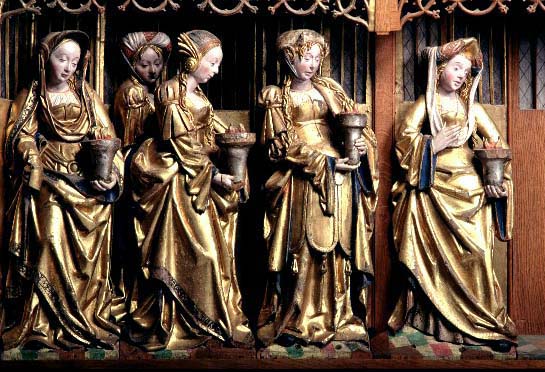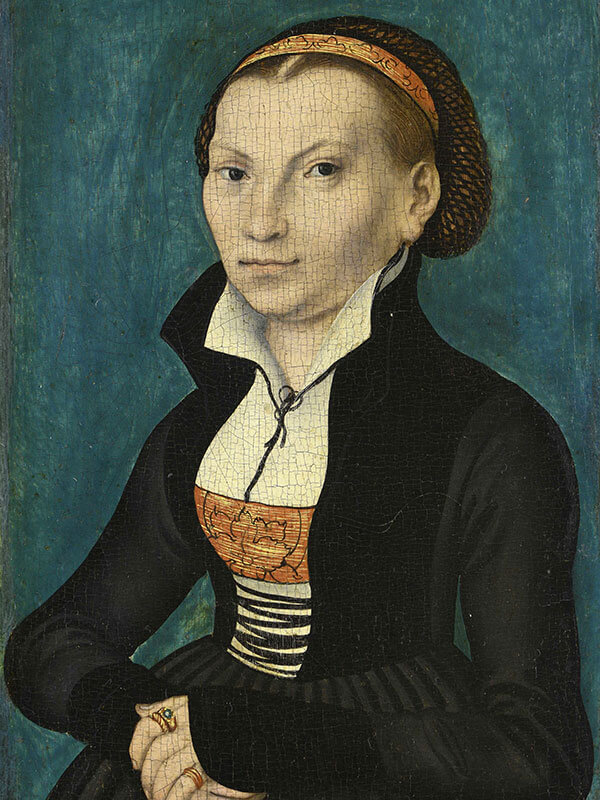So with that I have singled down my time period to the 1520s and my geographical area to Sweden. This is problematic since there are almost no sources for the early 16th Century, not even for the higher classes and even less for the lower classes. For the first gown in my 16th Century wardrobe I want to make clothes suitable for a master miner's wife or daughter. The master miners the ones controlling the mining and copper production in Falun. They were a class with a lot of Contact with the trading partners in the Baltic sea, the Church in Falun from the 15th Century is more connected to North German architecture than other Swedish churches. The most successful were able to send their sons to higher educations, and in this time period one of them would rise to be both a Bishop and member of the king's council. At the same time their wealth was based on themselves being able to handle all parts of the copper production, and they were also farmers and needed to support themselves and their underlings with what they could grow. This gives us a class with contacts, and possibility to import fashions, well outside the local area but at the same time they needed to be practical and working people as well.
I've spent some time gathering, and trying to organise my pinterest boad for the 16th Century, but here I will summarize my thoughts around it.
The main Resources if you want Contemporary depictions of clothing are altar Swedish altar shrines from the early 16th Century, Before the reformation. The problem is that most Swedish shrines were imported from the low countries, so they don't need to reference the local fashion. In religoius imagery there are also Conventions on how to portray holy figures, which makes them timeless. I've tried to avoid looking at how the MAdonna or St. Birgitta were portrayed, due to those Conventions, and instead looked at women that are supposedly less holy.
 |
| Vain maidens on a shrine from Vaksala, medeltidbild.historiska.se/medeltidbild/ |
The wide sleeves seems to get narrower closer to the 1520's though. Here I would like to add one of few portraits of an actual historical person. The portrait of Kristina Gyllenstierna on the shrine in Västerås.
This shrine was made in Antwerpen in 1516. Kristina Gyllenstierna was at this time married to the regent in Sweden, and the shrine was a gift from her and her husband. It is similar to other dresses, with a Square neckline and a skirt that pools around her. I'm Reading the photo to show a more pleated skirt than seen on the more religious figures, her sleeves are also tighter and there is possibly a little shift cuff at the end of the sleeve. Even if the shrine was made in Antwerpen, by a person who had never met Kristina Gyllenstierna, a rich and wealthy giver would probably have been disappointed if the woodcarver had shown her in old fashioned or odd clothes, so for that reason I still Think it can be an important reference.
For more Picture references it will be necessary to move outside of Sweden though. As I mentioned previously Sweden, and Falun, was well connected with the Baltic Sea trade. The main trading partner was Lübeck, more or less all copper from Falun was sold through Lübeck merchants, but from the late 15th Century Danzig, nowadays Gdansk in Poland, had started to challenge Lübeck as one of the major trading Towns on the Baltic. Looking at where the Swedish and Danish Royal houses chose to intermarry we end up with several states in northern Germany and along the German controlled Baltic coast. At the same time Sweden and Finland were one untied country and so one shouldn't forget the Finnish Resources.
This is a particularly nice portrait of a Young lady from Lübeck, dated to exactly 1520. Except for the interesting colourblocking she shows the same general elements of dress as Kristina Gyllenstierna, with a square neckline and a narrow but not tight sleeve.
From Turku/Åbo there is this Little fresco of a couple, dated to around 1530. The woman wears a shift with a collar, the skirt is pleated with a wide band of darker material and the sleeves are tight. Overall the style of dress reminds me a lot of Cranach's portrait of Katarina von Bora, wife of Martin Luther.
Katarina von Bora, is interesting because of her social class. She came from landed gentry but not the richest nobility. She came to take a prominent role in the reformation, and as wife to Martin Luther she developed the role of the respectable, protestant wife. This fits well with the master miners social standing as well.
Finally there is a source that I find very fascinating and that is because it actually shows working women. In the middle of the 16th Century the German Agricola set out to write down all available knowledge about mining and metal production. His book, De Re Metallica, is filled with woodcarvings showing all aspects of the industry, includng quite a few women.
Even if the woodcarvings are later than the 1520s, they probably depict a fashion that wasn't quite modern. Most of the dresses show similar elements though, with their Square necklines, some with guards, shifts with low necks or non-pleated collars, sleeves are either narrow or non-existant showing off the shift instead, the skirts are usually pleated.
Taking all these sources into account I Think it will be possible to create an outfit that wouldn't feel strange in Sweden in the 1520s. I'm thinking of doing a gown with Square neckline, long narrow sleeves and a skirt pleated to the bodice. To the neckline and probaly down the center front I will add guards, but I will not have any decorations on the skirt and no puffed or slashed sleeves. The shift should either be low necked, or have small collar with standing lapels.

.jpg)





















